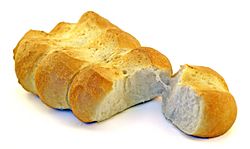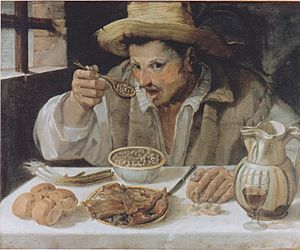Pane ticinese facts for kids
 |
|
| Type | Bread |
|---|---|
| Place of origin | Switzerland |
| Region or state | Ticino |
| Main ingredients | White flour, water, biga, salt, oil |
Pane ticinese is a yummy white bread that comes from Ticino, a region in Switzerland. You can find it all over Switzerland, where people often call it "Bread of Ticino." In its home region, it has other names like pane riga or reale.
This bread is special because of its unique shape. It's made of several small rolls joined together. You can easily break off a piece by hand! Also, oil is added to the dough, which makes the bread super soft and delicious.
The History of Pane Ticinese
A long time ago, in the early 1900s, white breads like pane ticinese were fancy foods. Most people in Ticino couldn't afford them. Instead, they usually ate bread made from rye or chestnut flour.
A book from the 1930s called Atlas of Swiss Folklore talked about this bread. It noted that pane ticinese was special because of its "sequential form." This means it was made of many small loaves connected together. You could easily break them apart by hand. One of its local names, riia pan, means "bread in a line," which describes its shape perfectly.
This unique bread shape actually came to Ticino from Italy. People in Italy had known about this style of bread for a long time. For example, a painting from 1584 by an Italian artist named Annibale Carracci shows a man eating. Next to him is a bread that looks very much like pane ticinese.
Back then, a whole Pane ticinese loaf weighed about 1 kilogram (2 pounds). It was made of eight small loaves joined together. You could buy the whole loaf or just parts of it, like half or a quarter. It was easy to break off the pieces you wanted.
In the 1950s, the Swiss Bakers' Association helped make this bread famous across Switzerland. They had a special school that created new breads based on old traditions from different Swiss regions. Pane ticinese became one of these popular specialty breads.
How Pane Ticinese is Made
Pane ticinese is made from a simple dough. The main ingredients are water, white flour, and a special mix called biga. Biga is a starter made from flour, yeast, and water. Salt is also added, and in today's recipes, a little bit of oil is included too.
First, the dough is mixed and kneaded. Then, it's divided into round pieces, each weighing about 2 kilograms. These pieces rest for a few minutes. After resting, they are kneaded again, flattened, and shaped into small individual loaves. These small loaves are called michette.
Each michetta is shaped by hand into an oval, about 10 centimeters long. Then, these small michette are carefully attached to each other to form one complete loaf of pane ticinese.
Before baking, the loaves are brushed with egg. They are then left to rise again until they double in size. Finally, they are baked for about 20 to 25 minutes. The oven temperature is around 190 °C (374 °F). The bread bakes until its crust turns a beautiful golden brown.
How Pane Ticinese is Used
Pane ticinese is a popular bread for everyday meals in Switzerland. You can find it in most Swiss bakeries and supermarkets. It's usually sold as one loaf made of four to six smaller pieces. These loaves are typically 20 to 25 centimeters long and weigh about 250 grams.
If the bread becomes a bit old or stale, people in Ticino sometimes use it to make a dish called torta leventinese. This is a type of bread pudding, which is a yummy way to use up leftover bread!
See also
 In Spanish: Pan tesinés para niños
In Spanish: Pan tesinés para niños


